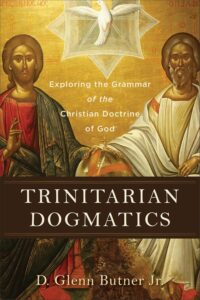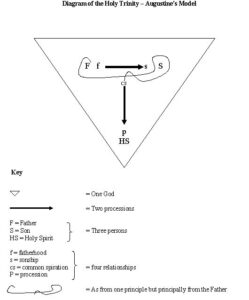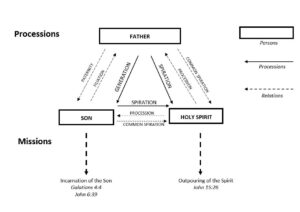
In my previous post, Salvation is Grounded in the Trinitarian Covenant of Redemption, I described how the plan of salvation which began with the “Father’s will” was then accepted for completion by the Son and fulfilled by the operation of the Holy Spirit raises a challenging question.1It should be noted the sequence is logical rather than temporal. “Given that any covenant is premised on a plurality of participants, doesn’t the theology of Covenant of Redemption” lead to the questionable doctrine of social trinitarianism or worse, the heresy of tritheism?”
Social trinitarianism may be represented by William Craig who teaches that the Father, Son and Holy Spirit are three distinct centres of consciousness, knowledge, will and intentionality. The three persons form a divine, transcendent “community”. Craig is careful to maintain that the divine community as a whole is the one God, and the three persons are not separate Gods.2William Craig, building on the analogy of Cerberus, the three-headed dog in Greek mythology, writes, “We naturally equate a rational soul with a person…human souls are individual persons [is] because each soul is equipped with one set of rational faculties sufficient for being a person. Suppose, then, that God is a soul that is endowed with three complete sets of rational cognitive faculties, each sufficient for personhood. Then God, though one soul, would not be one person but three, for God would have three centers of self-consciousness, intentionality, and volition, as social trinitarians maintain. God would clearly not be three discrete souls because the cognitive faculties in question are all faculties belonging to just one soul, one immaterial substance. God would therefore be one being that supports three persons, just as our own individual beings each support one person. Such a model of Trinity monotheism seems to give a clear sense to the classical formula “three persons in one substance.” J.P. Moreland & William Craig, Philosophical Foundations for a Christian Worldview 2e (IVP, 2017), pp. 592-593. Hence, he is advocating social trinitarianism rather than tritheism. Regardless, Craig’s model of the Trinity is evidently different from orthodox Nicene trinitarian model.
Tritheism may be represented by the Quran which suggests that the Christian Trinity which comprises the Father, Mother and Son, resulted from Christian misunderstanding of Jesus’ monotheistic teaching: Surah Al-Ma’idah (5:73): “Those people who say that God is the third of three are defying [the truth]: there is only One God.” (5:116): “When God says, ‘Jesus, son of Mary, did you say to people, “Take me and my mother as two gods alongside God”?’ he will say, May You be exalted! I would never say what I had no right to say.” [Abdel Haleem translation] However, one wonders how a “divinely revealed book” could commit such a grave misunderstanding of a fundamental Christian doctrine like the Trinity which was already well established as the normative doctrine throughout the Christian world at that time.
The Nicene Creed serves as the touchstone of the trinitarian orthodoxy and provides guard rails to prevent theological errors like tritheism. According to the Nicene Creed, the one eternal God comprises three persons (hypostasis), that is, the Father, Son and Holy Spirit who share the same, undivided essence (ousia) and eternally enjoy equal power and dignity. The persons are distinguished from one another by their “relations” with one another. Edmund Hill adds, “Now the Father, of course is God. Therefore he is not only Father, he is the fatherhood (the relationship) by which he is Father. So too the Son is the sonship by which he is Son. And the Holy Spirit – the relationship of being Gift, the relationship of ‘givenness’ if you like.”3Edmund Hill, The Mystery of the Trinity (Geoffrey Chapman, 1985), p. 93. See diag. 1 below which illustrates the processions and the relationships within the Trinity (immanent Trinity).

Diag.1
The processions refer to the internal life and eternal relationships within the Godhead which distinguish the three divine persons. The Father is distinguished as Father because he begets the Son, and the Son is distinguished as Son because he is begotten. The Spirit, similarly, is distinguished from Father and Son inasmuch as he is ‘spirated’ as the Spirit of communion of Father and Son.
The missions (see diag. 2 below) refer to the temporal sending of the divine Son and the Spirit into creation for the work of providence, revelation and salvation. The Father sends the Son while the Spirit proceeds from both the Father and Son.
These definitions clearly distinguish the persons’ intra-relationships (eternal processions) within the immanent Trinity from the persons’ work of salvation or temporal missions of the economic Trinity. The missions manifesting outwardly in time as the economic Trinity truly reveal who God is in se (in himself) but does not exhaustively reveal the immanent Trinity. See diag. 2.

Diag.2
We proceed with the fundamental premise that the persons of the trinity have one knowledge and will since they share the same undivided essence. Since there is no division in divine essence, the eternal processions between the three divine persons within the Trinity (immanent Trinity) do not lead to three separate centres of consciousness willing and acting independently from one another.
Glen Butner adds a careful description of the term “person” to ensure that the term is used properly in trinitarian theology:
“A divine person is a unique subsistence of the singular and rational divine nature that is distinguished from yet inseparably united with the other divine persons by the divine relations. The divine persons do not possess different natures, bodies, or material forms from one another, nor are they distinct centers of consciousness, willing, or knowledge. Rather, the fullness of the divine nature is hypostatized in its entirety in each person, indivisibly without splitting the divine nature into parts and irreducibly in a threefold relation.”4Butner adds, “Since the missions do not exhaustively disclose the Trinity, we should not read everything from the missions into the processions. For example, the Son submits to the Father in the divine economy (John 6:38), yet the processions themselves do not admit of any form of subordination.” 4Glen Butner, Trinitarian Dogmatics (Baker, 2022), p. 127, 171.
The Covenant of Redemption is not obtained within a divided, tripartite essence (ousia) of God with three independent wills. The Covenant is rather an agreement made between the persons (hypostasis) of the Trinity in the ad extra work of creation and redemption where the persons of the Triune God agree and work together in harmony to bring to fulfilment the Covenant of Redemption.
John Owen writes, the “Father, Son, and Spirit have not distinct wills” since they “are one God, and God’s will is one, as being an essential property of his nature.” The divine persons are not three separate centers of consciousness with ability to want, desire, and will independently from one another. Rather, they all share the same, singular, unified divine will so God’s will “is single and totally one in him.”5Cited in Harrison Perkins, Reformed Covenant Theology (Lexham Academic, 2024), p. 105. Hence, the unity and inseparable operations of the persons in the temporal missions as they execute the plan of salvation.
But how could there be a covenant if there is only one will? The answer is that the Father, Son, and Spirit with one unified knowledge and will decreed the plan of salvation even as the execution of the economy of redemption involves differing contributions from the Father, Son and Spirit in their missions. Francis Turretin explains, “As this work [the decree] is eternal, it is common and undivided to the whole Trinity with this distinction, however – that each person has his own proper and peculiar mode of operation here, agreeable to this saving economy” (1 Peter 1:2).
John Owen elaborates that God’s will concerning each person and his specific role in the plan of salvation belongs to the Father, Son, or Spirit specifically “though not exclusively,” since they share that will “by reason of their mutual inbeing.” Each person decrees the plan of salvation but not independently of the other two. The Triune God, as such, decrees by a single will how each person of the Godhead has a mission that distinctly contributes to salvation within the plan of redemption.6Quotations from Turretin and Owen are taken from Perkins, Reformed Covenant Theology, pp. 111-112.
Each person executes the same will, each in their “distinct manner” in accord with their distinct personalities. In sharing one will, they work harmoniously with one another in the ad extra work of God in creation and salvation. The Father sends the Son into the world who accepts his role not according to his place in the procession, but according to his mission to the save those who believe in him. The Holy Spirit in his mission applies the achievement of Christ work on the cross to gather the elect into the body of Christ, the Church.
There is equality between the one sent and the one sending as the temporal missions mirror externally the internal relationships within the Godhead. Kevin Vanhoozer’s elaboration on the mirror relationship between the temporal missions and the eternal processions of the Trinity is insightful: “Because the way God is in the economy [i.e., in the dialogues that take place between the Father and the Son in time and space] corresponds to the way God is in himself, we may conclude that the Father, Son, and Spirit are merely continuing in history a communicative activity that characterizes their perfect life together.”7Kevin Vanhoozer, Remythologizing Theology: Divine Action, Passion, and Authorship (Cambridge Uni. Pess, 2010), 251.
To conclude, the persons of the Trinity together, with one will decreed how each person carries out his distinct mission in accomplishing the divine plan of salvation. There is then no hint of or place for tritheism in the Covenant of Redemption. Salvation is planned and executed by the One Triune God who is Father, Son and Holy Spirit.
Related Posts
Is the Trinity Monotheism? Dr. Ali Ataie vs. Dr. Joshua Sijuwade. A Debate hosted by Blogging Theology
Of course, not forgetting those who are unfamiliar with the Christian doctrine of the Trinity:
Doctrine of the Trinity: A Primer